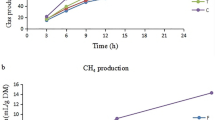Abstract
Growth ofSelenomonas ruminantium HD4 in medium that contained 21mm d-lactate was stimulated to varying degrees by 10mm l-malate, 10mm fumarate, and 2% (v/v)Aspergillus oryzae fermentation extract (Amaferm). Amaferm treatment caused the greatest growth stimulation. Initial uptake rates (30s) and long-term uptake rates (30 min) ofd-lactate by whole cells ofS. ruminantium were increased in the presence of 10mm l-malate. Amaferm (25 μl/ml) also stimulated long-term uptake rates ofd-lactate, whereas fumarate had no effect. Initial uptake ofd-lactate was depressed in the presence of fumarate or Amaferm. When eitherl-malate, fumarate, or Amaferm was included in thed-lactate growth medium, a homosuccinate fermentation resulted and an inverse relationship was observed between growth (protein synthesis) and succinate production. Recent research demonstrated that Amaferm containsl-malate, and this dicarboxylic acid may be involved in stimulatingd-lactate utilization byS. ruminantium.
Similar content being viewed by others
Literature Cited
Bryant MP (1956) The characteristics of strains ofSelenomonas isolated from bovine rumen contents. J Bacteriol 72:162–167
Caldwell DR, Bryant MP (1966) Medium without rumen fluid for non-selective enumeration and isolation of rumen bacteria. Appl Microbiol 14:794–801
Dunlop RH, Hammond PB (1965)d-Lactic acidosis of ruminants. Ann New York Acad Sci 119:1109–1132
Kanegasaki S, Takahashi H (1967) Function of growth factors for rumen microorganisms. I. Nutritional characteristics ofSelenomonas ruminantium. J Bacteriol 93:456–463
Lindgren S, Lingvall P, Kaspersson A, de Kartzow A, Rydberg E (1983) Effect of inoculants, grain and formic acid on silage fermentation. Swedish J Agric Res 13:91–100
Linehan B, Scheifinger CC, Wolin MJ (1978) Nutritional requirements ofSelenomonas ruminantium for growth on lactate, glycerol, or glucose. Appl Environ Microbiol 35.:317–322
Lowry OJ, Rosebrough NJ, Farr AL, Randall RJ (1951) Protein measurement with the Folin phenol reagent. J Biol Chem 193:265–275
Martin SA, Nisbet DJ (1990) Effects ofAspergillus oryzae fermentation extract on fermentation of amino acids, bermudagrass and starch by mixed ruminal microorganisms in vitro. J Anim Sci 68:2142–2149
Martin SA, Russell JB (1986) Phosphoenolpyruvate-dependent phosphorylation of hexoses by ruminal bacteria: evidence for the phosphotransferase transport system. Appl Environ Microbiol 52:1348–1352
Martin SA, Russell JB (1988) Mechanisms of sugar transport in the rumen bacteriumSelenomonas ruminantium. J Gen Microbiol 134:819–827
Melville SB, Michel TA, Macy JM (1987) Involvement ofd-lactate and lactic acid racemase in the metabolism of glucose bySelenomonas ruminantium. FEMS Microbiol Lett 40: 289–293
Nisbet DJ, Martin SA (1990) Effect of dicarboxylic acids andAspergillus oryzae fermentation extract on lactate uptake by the ruminal bacteriumSelenomonas ruminantium. Appl Environ Microbiol 56:3515–3518
Nisbet DJ, Martin SA (1991) Effect of aSaccharomyces cerevisiae culture on lactate utilization by the ruminal bacteriumSelenomonas ruminantium. J Anim Sci 69:4628–4633
Raper KB, Fennell DI (1965) The genusAspergillus Baltimore: Williams and Wilkins, pp 357–404
Russell JB (1983) Fermentation of peptides byBacteroides ruminicola BI4. Appl Environ Microbiol 45:1566–1574
Sakaguchi K, Takahashi H, Morino H (1953) Studies on the production of α-ketoglutaric acid by molds. J Agric Chem Soc (Japan) 23:591–595
Scheifinger CC, Latham MJ, Wolin MJ (1975) Relationship of lactate dehydrogenase specificity and growth rate to lactate metabolism bySelenomonas ruminantium. Appl Environ Microbiol 30:916–921
Author information
Authors and Affiliations
Rights and permissions
About this article
Cite this article
Nisbet, D.J., Martin, S.A. Effects of fumarate,l-malate, and anAspergillus oryzae fermentation extract ond-lactate Utilization by the ruminal bacteriumSelenomonas ruminantium . Current Microbiology 26, 133–136 (1993). https://doi.org/10.1007/BF01577366
Issue Date:
DOI: https://doi.org/10.1007/BF01577366




